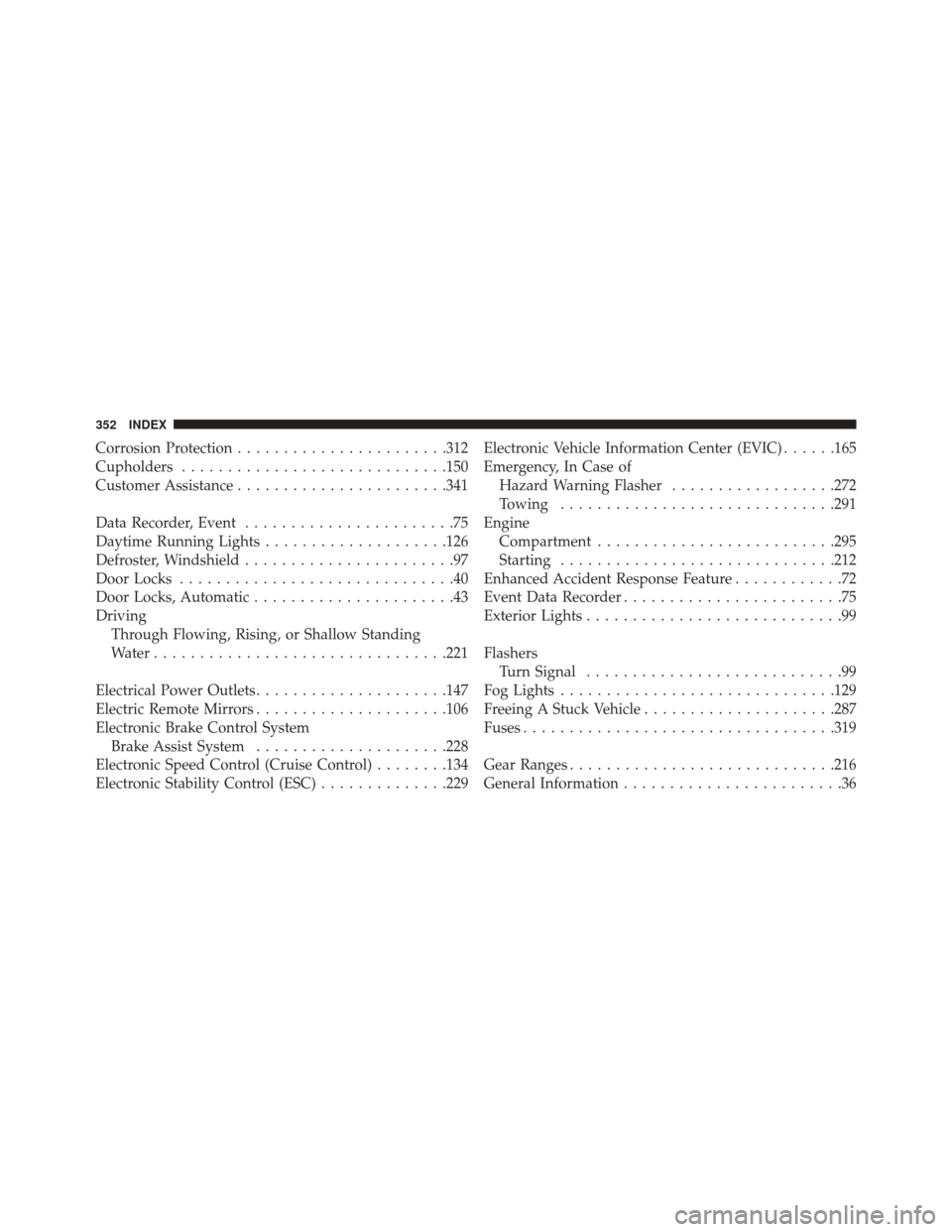Page 324 of 363
CavityVehicle
Fuse
Number Mini
Fuse Description
13 F31 5 Amp Ta nIgnition, Climate
Control, RDU and
EVCU
14 F47 20 Amp YellowDriver Power
Window
The fuse for the heated mirrors is located behind an
access panel on the front of the Instrument Panel.
NOTE: This fuse is a single fuse attached directly to the
wire harness.
1 — Heated Mirror Fuse 2 — Access Panel
Cavity Mini Fuse Description
F90 5 Amp Tan Heated Mirrors
F90 Fuse Location
322 MAINTAINING YOUR VEHICLE
Page 325 of 363
Power Distribution Center #1
The Power Distribution Center #1 is located on the right
side of the underhood compartment. To access the fuses,
remove locking screw and slide cover off.The ID number of the electrical component correspond-
ing to each fuse can be found on the back of the cover.
Cavity
Maxi
Fuse Mini Fuse Description
F01 60 Amp Blue Body Control
Module (BCM)
F02 20 Amp Yellow HiFi Amplifier
F03 20 Amp Yellow Ignition Switch
F04 40 Amp Orange Brake System
Module Pump
F05 70 Amp Ta n Electric Power
Steering (EPS)
F06 60 Amp Blue Radiator Fan
F07 40 Amp Orange Regen Brake
Module
Front Distribution Unit
7
MAINTAINING YOUR VEHICLE 323
Page 326 of 363
CavityMaxi
Fuse Mini Fuse Description
F08 40 Amp Orange HVAC
F09 5 Amp
Ta n Air Electric Heater
Charge Indicator
F10 10 Amp
Red Horn
F11 10 Amp
Red Electronic Vehicle
Control Unit
(EVCU)
F14 5 Amp
Ta n High Beam
(Shutter)
F15 15 Amp
Blue Cigar Lighter
F16 10 Amp
Red Humidity Sensor
VPAM
AC CompressorCavity
Maxi
Fuse Mini Fuse Description
F18 5 Amp
Ta n Electronic Vehicle
Control Unit
(EVCU)
F19 10 Amp
Red HVAC
F20 15 Amp
Blue Heated Seats –
If Equipped
F23 25 Amp
Clear Anti-Lock Brake
Valves
F24 7.5 Amp
Brown EPS
YAW Sensor
F30 15 Amp
Blue Fog Lamps
F81 30 Amp Green Electronic Shifter
(ESM)
324 MAINTAINING YOUR VEHICLE
Page 327 of 363
CavityMaxi
Fuse Mini Fuse Description
F82 30 Amp Green Sunroof
F84 25 Amp
Clear Regen Brake
Module
F85 30 Amp Green Rear Window
Heater
F87 5 Amp
Ta n Electronic Shifter
(ESM)
Power Distribution Center (PDC) #2
The Power Distribution Center #2 is located next to the
battery in the underhood compartment. To access the
fuses, pull the release tabs and remove the cover.
Cavity Maxi
Fuse Mini
FuseDescription
FPT9 15 Amp
Blue Battery Pack Control
Module (BPCM)
Power Inverter
Module (PIM)
PDC #2
7
MAINTAINING YOUR VEHICLE 325
Page 328 of 363

Cavity MaxiFuse Mini
FuseDescription
FPT13 10 Amp
Red
EAC (AC Compressor)
On Board Charging
Module (OBCM)
FPT16 5 Amp
Ta n Intelligent Battery
Sensor (IBS)
FPT17 10 Amp
Red
EAC (AC Compressor)
Radiator Fan
FPT20 10 Amp
Red
Electronic Vehicle
Control Unit (EVCU)
Cavity Cartridge Fuse Description
FPT3 25 Amp White Battery Coolant
Pump
FPT5 20 Amp Lt. Blue Inverter Coolant
Pump
VEHICLE STORAGE
The preferred way of storing your vehicle for a long
period of time is to leave it attached to a Level 1 or Level
2 charger. The vehicle has a wake-up feature that will
wake the system every 3 weeks and do a maintenance
charge on the 12 Volt battery and also top off the high
voltage battery if necessary.
Anytime you store your vehicle, or keep it out of service
(e.g., vacation) for two weeks or more, run the air
conditioning system at idle for about five minutes in the
fresh air and high blower setting. This will ensure
adequate system lubrication to minimize the possibility
of compressor damage when the air conditioning system
is started again.
326 MAINTAINING YOUR VEHICLE
Page 354 of 363

Corrosion Protection...................... .312
Cupholders ............................ .150
Customer Assistance ...................... .341
Data Recorder, Event .......................75
Daytime Running Lights ....................126
Defroster, Windshield .......................97
Door Locks ..............................40
Door Locks, Automatic ......................43
Driving Through Flowing, Rising, or Shallow Standing
Water ............................... .221
Electrical Power Outlets .....................147
Electric Remote Mirrors .....................106
Electronic Brake Control System Brake Assist System .....................228
Electronic Speed Control (Cruise Control) ........134
Electronic Stability Control (ESC) ..............229Electronic Vehicle Information Center (EVIC)
......165
Emergency, In Case of Hazard Warning Flasher ..................272
Towing ............................. .291
Engine Compartment ......................... .295
Starting ............................. .212
Enhanced Accident Response Feature ............72
Event Data Recorder ........................75
Exterior Lights ............................99
Flashers Turn Signal ............................99
Fog Lights ............................. .129
Freeing A Stuck Vehicle .....................287
Fuses ................................. .319
Gear Ranges ............................ .216
General Information ........................36
352 INDEX
Page 362 of 363

INSTALLATION OF RADIO TRANSMITTING
EQUIPMENT
Special design considerations are incorporated into this vehicle’s
electronic system to provide immunity to radio frequency signals.
Mobile two-way radios and telephone equipment must be
installed properly by trained personnel. The following must be
observed during installation.
The positive power connection should be made directly to the
battery and fused as close to the battery as possible. The negative
power connection should be made to body sheet metal adjacent
to the negative battery connection. This connection should not
be fused.
Antennas for two-way radios should be mounted on the roof or
the rear area of the vehicle. Care should be used in mounting
antennas with magnet bases. Magnets may affect the accuracy or
operation of the compass on vehicles so equipped.The antenna cable should be as short as practical and routed
away from the vehicle wiring when possible. Use only fully
shielded coaxial cable.
Carefully match the antenna and cable to the radio to ensure a
low Standing Wave Ratio (SWR).
Mobile radio equipment with output power greater than normal
may require special precautions.
All installations should be checked for possible interference
between the communications equipment and the vehicle’s elec-
tronic systems.